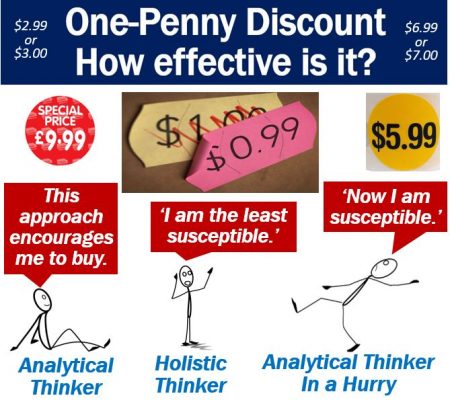Will a one-penny discount encourage shoppers to rush to the checkout counter? In other words, does a $2.99 price pull in more sales than a $3.00 price? Researchers from Baylor University’s Hankamer School of Business say that the one-penny discount approach is sometimes but not always effective. It depends on the shopper’s thinking style.
Lead author, Lingjiang Lora Tu, Ph.D. and co-author Chris Pullig, Ph.D. wrote about their study in the journal Marketing Letters (citation below).
Prof. Tu is assistant clinical professor of Marketing, and Prof. Pullig is professor and chair of Baylor’s marketing department.
In the study, which involved 932 consumers, the researchers carried out four experiments. The experiments revealed that marketers need to focus on their target consumers’ thinking styles. That is, if they want to get better sales with a one-penny price discount approach. They may even have to modify consumers’ thinking styles.
Prof. Lora Tu, assistant professor of marketing at Baylor, said:
“We looked specifically at two styles of thinking – analytic and holistic.”
The authors explained that analytic thinkers tend to view each digit in a price as independent and separate. Their focus object is the left-most digit.
Holistic thinkers, on the other hand, generally view all the digits as interconnected. In other words, for them, each digit is an inseparable part of the price.

One-penny discount – study results
The one-penny discount approach is more effective with analytical thinkers than holistic thinkers.
In other words, a $2.99 rather than a $3.00 price works better on analytical than holistic thinkers. ‘Works better,’ that is, for boosting sales.
Prof. Tu said:
“Analytic thinkers tend to view the nine-ending price as lower because of the difference in the left-most digit. In contrast, holistic thinkers tend to view all price digits as a whole and are less subject to the nine-ending price effect.”
“We identified that when individuals are more inclined to holistic thinking (versus analytic thinking), the effectiveness of a nine-ending pricing tactic is pretty weak.”

One-penny discount and limited cognitive resources
However, when cognitive resources are limited, the one-penny price drop is more effective. When holistic thinkers are pushed for time, i.e., in a hurry, for example, their cognitive resources are limited.
Regarding holistic thinkers, Prof. Tu said:
“Holistic thinkers are not always immune to nine-ending prices. Our research shows that holistic thinking takes more cognitive resources than analytic thinking.”
“When their cognitive resources are limited by time pressure or distractions, holistic thinkers respond to nine-ending prices the same way analytic thinkers do. That is, they view a nine-ending price as much lower than a round price just one cent higher.”
Anything that limits both holistic and analytical thinkers’ cognitive resources makes them more vulnerable. Specifically, more vulnerable to the one-penny discount approach, i.e., a $2.99 rather than a $3.00 price.
Apart from time pressure, background music and an interactive product demonstration also limit cognitive resources.
Manipulating and measuring thinking styles
It is possible to measure holistic thinking styles, the authors wrote. It is also possible to manipulate them. Marketers can achieve this via communication strategies.
Promotion imagery, website design, and message framing, for example, are types of communication strategies. A retailer’s environment is also a communication strategy option.
These communication strategies can make pricing tactics, such as the one-penny discount approach, more effective.
Since the advent of the Internet and online shopping, marketing executives have had to change their strategies. Online shopping means purchasing goods on the Internet. We also use the term for purchasing services.
Chronologically analytical/holistic thinkers
Chronologically analytical thinkers are more susceptible to the one-penny discount approach than chronologically holistic thinkers.
Westerners and individualists, for example, are chronologically analytic thinkers. East Asians and collectivists, on the other hand, are chronologically holistic thinkers.
The authors wrote:
“Given growing cultural diversity of most major markets, identifying chronically holistic and analytic thinkers in regional and local markets will boost the effectiveness and predictive accuracy of managers’ pricing policies.”
Journal Abstract
In an Abstract that precedes the main article in the journal, the authors wrote:
“Our results demonstrate that holistic thinkers are not responsive to nine-ending prices when they have unlimited cognitive resources.”
“With limited cognitive resources (e.g., under time pressure or cognitive load), both holistic and analytic thinkers are subject to the nine-ending price effect.”
Citation:
“Penny wise and pound foolish? How thinking style affects price cognition,” Lingjiang Lora Tu and Chris Pullig. Marketing Letters, June 2018, Volume 29, Issue 2, pp 261–273. DOI: https://doi.org/10.1007/s11002-018-9460-y

